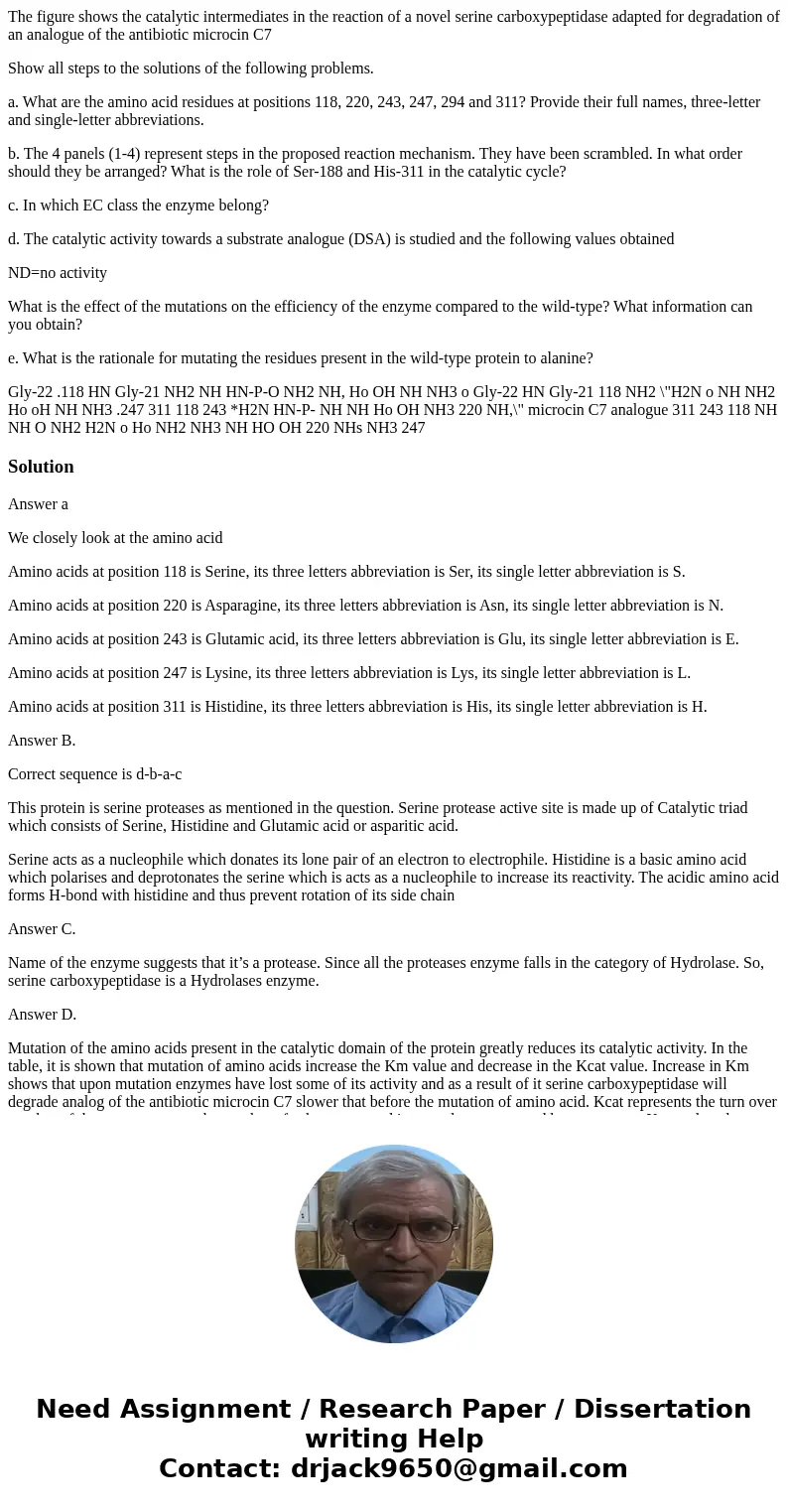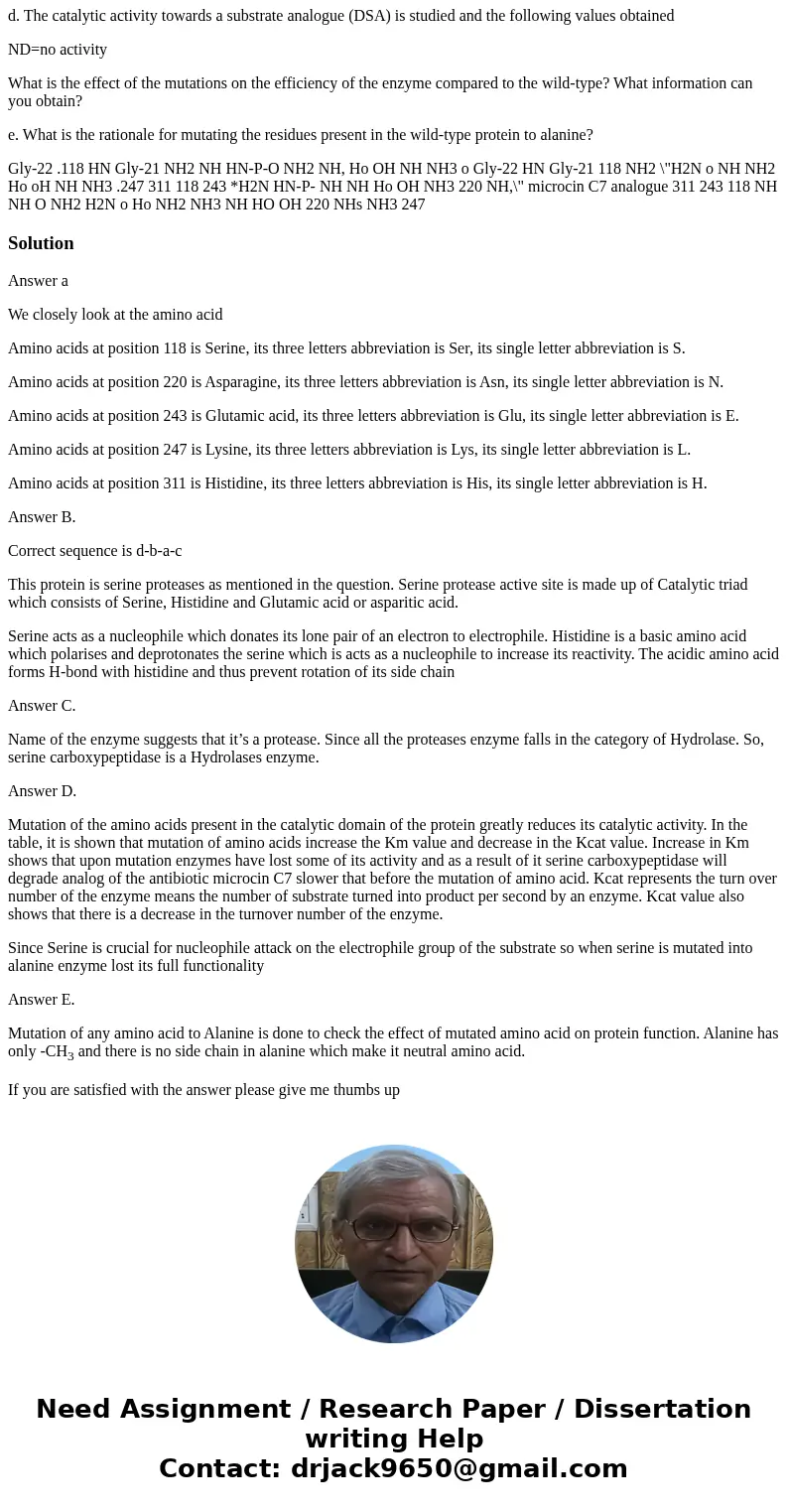The figure shows the catalytic intermediates in the reaction
The figure shows the catalytic intermediates in the reaction of a novel serine carboxypeptidase adapted for degradation of an analogue of the antibiotic microcin C7
Show all steps to the solutions of the following problems.
a. What are the amino acid residues at positions 118, 220, 243, 247, 294 and 311? Provide their full names, three-letter and single-letter abbreviations.
b. The 4 panels (1-4) represent steps in the proposed reaction mechanism. They have been scrambled. In what order should they be arranged? What is the role of Ser-188 and His-311 in the catalytic cycle?
c. In which EC class the enzyme belong?
d. The catalytic activity towards a substrate analogue (DSA) is studied and the following values obtained
ND=no activity
What is the effect of the mutations on the efficiency of the enzyme compared to the wild-type? What information can you obtain?
e. What is the rationale for mutating the residues present in the wild-type protein to alanine?
Gly-22 .118 HN Gly-21 NH2 NH HN-P-O NH2 NH, Ho OH NH NH3 o Gly-22 HN Gly-21 118 NH2 \"H2N o NH NH2 Ho oH NH NH3 .247 311 118 243 *H2N HN-P- NH NH Ho OH NH3 220 NH,\" microcin C7 analogue 311 243 118 NH NH O NH2 H2N o Ho NH2 NH3 NH HO OH 220 NHs NH3 247Solution
Answer a
We closely look at the amino acid
Amino acids at position 118 is Serine, its three letters abbreviation is Ser, its single letter abbreviation is S.
Amino acids at position 220 is Asparagine, its three letters abbreviation is Asn, its single letter abbreviation is N.
Amino acids at position 243 is Glutamic acid, its three letters abbreviation is Glu, its single letter abbreviation is E.
Amino acids at position 247 is Lysine, its three letters abbreviation is Lys, its single letter abbreviation is L.
Amino acids at position 311 is Histidine, its three letters abbreviation is His, its single letter abbreviation is H.
Answer B.
Correct sequence is d-b-a-c
This protein is serine proteases as mentioned in the question. Serine protease active site is made up of Catalytic triad which consists of Serine, Histidine and Glutamic acid or asparitic acid.
Serine acts as a nucleophile which donates its lone pair of an electron to electrophile. Histidine is a basic amino acid which polarises and deprotonates the serine which is acts as a nucleophile to increase its reactivity. The acidic amino acid forms H-bond with histidine and thus prevent rotation of its side chain
Answer C.
Name of the enzyme suggests that it’s a protease. Since all the proteases enzyme falls in the category of Hydrolase. So, serine carboxypeptidase is a Hydrolases enzyme.
Answer D.
Mutation of the amino acids present in the catalytic domain of the protein greatly reduces its catalytic activity. In the table, it is shown that mutation of amino acids increase the Km value and decrease in the Kcat value. Increase in Km shows that upon mutation enzymes have lost some of its activity and as a result of it serine carboxypeptidase will degrade analog of the antibiotic microcin C7 slower that before the mutation of amino acid. Kcat represents the turn over number of the enzyme means the number of substrate turned into product per second by an enzyme. Kcat value also shows that there is a decrease in the turnover number of the enzyme.
Since Serine is crucial for nucleophile attack on the electrophile group of the substrate so when serine is mutated into alanine enzyme lost its full functionality
Answer E.
Mutation of any amino acid to Alanine is done to check the effect of mutated amino acid on protein function. Alanine has only -CH3 and there is no side chain in alanine which make it neutral amino acid.
If you are satisfied with the answer please give me thumbs up


 Homework Sourse
Homework Sourse